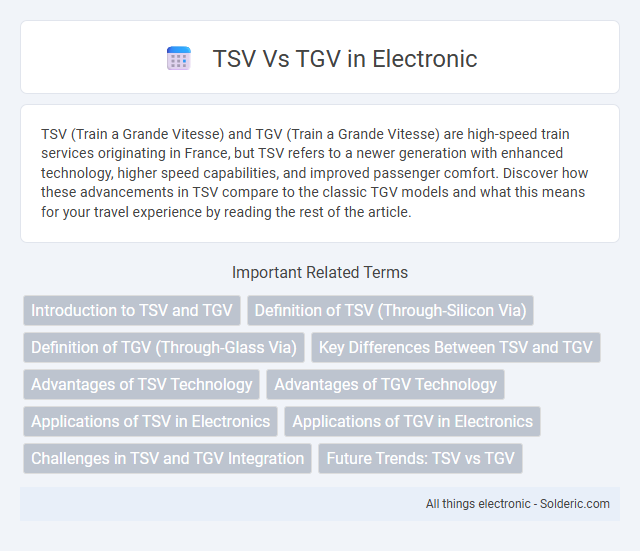TSV (Train a Grande Vitesse) and TGV (Train a Grande Vitesse) are high-speed train services originating in France, but TSV refers to a newer generation with enhanced technology, higher speed capabilities, and improved passenger comfort. Discover how these advancements in TSV compare to the classic TGV models and what this means for your travel experience by reading the rest of the article.
Comparison Table
| Feature | TSV (Tab-Separated Values) | TGV (Train a Grande Vitesse) |
|---|---|---|
| Definition | File format using tabs to separate data fields in plain text. | French high-speed train service operating at speeds up to 320 km/h. |
| Primary Use | Data storage and exchange in spreadsheet and database applications. | High-speed passenger rail transportation in France and neighboring countries. |
| File Extension / Identifier | .tsv | No file extension, transportation service name. |
| Data Format | Plain text with tab characters (\t) separating columns. | N/A (Transportation system). |
| Speed | Not applicable. | Operational speeds up to 320 km/h (199 mph). |
| Industry | Information Technology, Data Management. | Rail Transport, Public Transportation. |
| Key Advantage | Simple, human-readable, easy to import/export across systems. | Fast, efficient travel reducing journey times significantly. |
Introduction to TSV and TGV
TSV (Transport a Grande Vitesse) and TGV (Train a Grande Vitesse) are both French high-speed train systems, with TGV being the more widely known and pioneering service launched in 1981 by SNCF. TSV, while less common, refers to a newer generation or variant rail technology designed to complement or extend the capabilities of traditional TGV services by integrating advanced features and routes. Understanding the differences between TSV and TGV can help you navigate the French rail network more effectively for high-speed travel.
Definition of TSV (Through-Silicon Via)
TSV (Through-Silicon Via) is a vertical electrical connection that passes through a silicon wafer or die, enabling three-dimensional (3D) stacking of integrated circuits and significantly enhancing performance and reducing power consumption. Unlike TGV (Through-Glass Via), which penetrates glass substrates primarily for optical and RF applications, TSV is crucial in semiconductor packaging for enabling high-density, low-latency interconnects. Your advanced electronic designs benefit from TSV technology by achieving greater miniaturization and improved signal integrity.
Definition of TGV (Through-Glass Via)
The definition of TGV (Through-Glass Via) refers to a vertical electrical connection that passes through a glass substrate, enabling high-density interconnections in microelectronics. Unlike traditional TSV (Through-Silicon Via) used in silicon wafers, TGV offers superior insulation and reduced parasitic capacitance, which enhances signal integrity and performance in high-frequency applications. Your choice between TSV and TGV depends on the specific material properties and application requirements, with TGV excelling in scenarios demanding low-loss and miniaturized interconnects.
Key Differences Between TSV and TGV
TSV (Train a Grande Vitesse) and TGV (Train a Grande Vitesse) both refer to high-speed trains in France, but they differ in scope and application. TGV specifically designates France's original high-speed rail service introduced in 1981, known for using standard gauge tracks and speeds up to 320 km/h. TSV often refers to broader high-speed train technology, including international variants or newer models with advanced features, so understanding these distinctions helps you choose the best option for efficient travel.
Advantages of TSV Technology
TSV (Through-Silicon Via) technology offers significant advantages in 3D IC integration by enabling shorter interconnect lengths, which reduce signal delay and power consumption compared to traditional TGV (Through-Glass Via) methods. TSV provides higher density and better electrical performance due to its ability to create vertical connections directly through silicon wafers, improving bandwidth and overall system efficiency. Enhanced thermal management and mechanical robustness are also key benefits of TSV, making it a preferred choice in advanced semiconductor packaging.
Advantages of TGV Technology
TGV technology offers superior speed capabilities, reaching up to 320 km/h, significantly reducing travel time compared to TSV systems. The advanced aerodynamics and dedicated high-speed tracks enhance energy efficiency and stability, allowing for smoother and safer journeys. TGV trains also accommodate higher passenger capacities with improved comfort, making them ideal for densely populated routes and long-distance travel.
Applications of TSV in Electronics
Through-Silicon Vias (TSVs) are critical in 3D integrated circuits, enabling vertical stacking of chips to enhance performance and reduce latency in advanced electronics. They provide efficient interconnects for high-bandwidth memory, sensors, and heterogeneous integration in devices like smartphones, AI processors, and data centers. TSV technology supports miniaturization and power efficiency, driving innovations in semiconductor packaging and system-on-chip designs.
Applications of TGV in Electronics
TGV (Through Glass Via) technology enables vertical electrical connections through glass substrates, crucial for high-frequency and high-precision electronic applications such as RF components, MEMS devices, and advanced sensors. Unlike TSV (Through Silicon Via), TGV offers superior dielectric properties and lower signal loss, enhancing the performance of devices used in telecommunications and aerospace industries. Your designs can benefit from TGV integration by achieving improved signal integrity, miniaturization, and thermal stability in next-generation electronic modules.
Challenges in TSV and TGV Integration
TSV (Through-Silicon Via) and TGV (Through-Glass Via) integration faces significant challenges including material compatibility, thermal expansion mismatch, and process complexity. TSVs often encounter issues with silicon cracking and dielectric reliability, while TGVs struggle with glass brittleness and via sealing. Addressing these challenges requires advanced fabrication techniques and precise alignment to ensure electrical performance and structural integrity in 3D packaging applications.
Future Trends: TSV vs TGV
Future trends in high-speed rail focus on improving efficiency, sustainability, and speed, with TSV (Transport a Grande Vitesse) and TGV (Train a Grande Vitesse) both advancing technologies in aerodynamics and energy consumption. Innovations include enhanced signaling systems, integration of renewable energy sources, and smart infrastructure to optimize travel times and reduce environmental impact. Your travel experience will benefit from these improvements as both TSV and TGV evolve to meet increasing demands for faster, greener transportation.
TSV vs TGV Infographic

 solderic.com
solderic.com